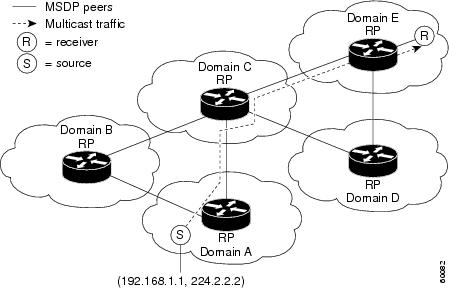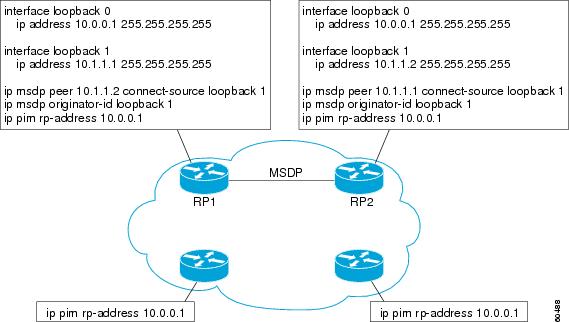Anycast RP
Version History
|
Version Number
|
Date
|
Notes
|
|---|---|---|
1
|
06/18/2001
|
This document was created.
|
2
|
10/15/2001
|
"Anycast RP Example" section was updated.
|
3
|
11/19/2001
|
Figure 2 was updated.
|
IP multicast is deployed as an integral
component in mission-critical networked applications throughout the
world. These applications must be robust, hardened, and scalable to
deliver the reliability that users demand.
Using Anycast RP is an implementation strategy
that provides load sharing and redundancy in Protocol Independent
Multicast sparse mode (PIM-SM) networks. Anycast RP allows two or more
rendezvous points (RPs) to share the load for source registration and
the ability to act as hot backup routers for each other. Multicast
Source Discovery Protocol (MSDP) is the key protocol that makes Anycast
RP possible.
The scope of this document is to explain the
basic concept of MSDP and the theory behind Anycast RP. It also provides
an example of how to deploy Anycast RP.
This document has the following sections:
Multicast Source Discovery Protocol Overview
In the PIM sparse mode model, multicast sources
and receivers must register with their local rendezvous point (RP).
Actually, the router closest to a source or a receiver registers with
the RP, but the key point to note is that the RP "knows" about all the
sources and receivers for any particular group. RPs in other domains
have no way of knowing about sources located in other domains. MSDP is
an elegant way to solve this problem.
MSDP is a mechanism that allows RPs to share
information about active sources. RPs know about the receivers in their
local domain. When RPs in remote domains hear about the active sources,
they can pass on that information to their local receivers. Multicast
data can then be forwarded between the domains. A useful feature of MSDP
is that it allows each domain to maintain an independent RP that does
not rely on other domains, but it does enable RPs to forward traffic
between domains. PIM-SM is used to forward the traffic between the
multicast domains.
The RP in each domain establishes an MSDP
peering session using a TCP connection with the RPs in other domains or
with border routers leading to the other domains. When the RP learns
about a new multicast source within its own domain (through the normal
PIM register mechanism), the RP encapsulates the first data packet in a
Source-Active (SA) message and sends the SA to all MSDP peers. Each
receiving peer uses a modified Reverse Path Forwarding (RPF) check to
forward the SA, until the SA reaches every MSDP router in the
interconnected networks—theoretically the entire multicast internet. If
the receiving MSDP peer is an RP, and the RP has a (*, G) entry for the
group in the SA (there is an interested receiver), the RP creates (S, G)
state for the source and joins to the shortest path tree for the
source. The encapsulated data is decapsulated and forwarded down the
shared tree of that RP. When the last hop router (the router closest to
the receiver) receives the multicast packet, it may join the shortest
path tree to the source. The MSDP speaker periodically sends SAs that
include all sources within the domain of the RP. Figure 1 shows how data would flow between a source in domain A to a receiver in domain E.
MSDP was developed for peering between Internet
service providers (ISPs). ISPs did not want to rely on an RP maintained
by a competing ISP to provide service to their customers. MSDP allows
each ISP to have its own local RP and still forward and receive
multicast traffic to the Internet.
Figure 1 MSDP Example: MSDP Shares Source Information Between RPs in Each Domain

Anycast RP Overview
Anycast RP is a useful application of MSDP.
Originally developed for interdomain multicast applications, MSDP used
for Anycast RP is an intradomain feature that provides redundancy and
load-sharing capabilities. Enterprise customers typically use Anycast RP
for configuring a Protocol Independent Multicast sparse mode (PIM-SM)
network to meet fault tolerance requirements within a single multicast
domain.
In Anycast RP, two or more RPs are configured
with the same IP address on loopback interfaces. The Anycast RP loopback
address should be configured with a 32-bit mask, making it a host
address. All the downstream routers should be configured to "know" that
the Anycast RP loopback address is the IP address of their local RP. IP
routing automatically will select the topologically closest RP for each
source and receiver. Assuming that the sources are evenly spaced around
the network, an equal number of sources will register with each RP. That
is, the process of registering the sources will be shared equally by
all the RPs in the network.
Because a source may register with one RP and
receivers may join to a different RP, a method is needed for the RPs to
exchange information about active sources. This information exchange is
done with MSDP.
In Anycast RP, all the RPs are configured to be
MSDP peers of each other. When a source registers with one RP, an SA
message will be sent to the other RPs informing them that there is an
active source for a particular multicast group. The result is that each
RP will know about the active sources in the area of the other RPs. If
any of the RPs were to fail, IP routing would converge and one of the
RPs would become the active RP in more than one area. New sources would
register with the backup RP. Receivers would join toward the new RP and
connectivity would be maintained.
Note that the RP is normally needed only to
start new sessions with sources and receivers. The RP facilitates the
shared tree so that sources and receivers can directly establish a
multicast data flow. If a multicast data flow is already directly
established between a source and the receiver, then an RP failure will
not affect that session. Anycast RP ensures that new sessions with
sources and receivers can begin at any time.
Anycast RP Example
The main purpose of an Anycast RP
implementation is that the downstream multicast routers will "see" just
one address for an RP. The example given in Figure 2
shows how the loopback 0 interface of the RPs (RP1 and RP2) is
configured with the same 10.0.0.1 IP address. If this 10.0.0.1 address
is configured on all RPs as the address for the loopback 0 interface and
then configured as the RP address, IP routing will converge on the
closest RP. This address must be a host route—note the 255.255.255.255
subnet mask.
The downstream routers must be informed about the 10.0.0.1 RP address. In Figure 2, the routers are configured statically with the ip pim rp-address 10.0.0.1
global configuration command. This configuration could also be
accomplished using the Auto-RP or bootstrap router (BSR) features.
The RPs in Figure 2
must also share source information using MSDP. In this example, the
loopback 1 interface of the RPs (RP1 and RP2) is configured for MSDP
peering. The MSDP peering address must be different than the Anycast RP
address.
Figure 2 Anycast RP Configuration

Many routing protocols choose the highest IP
address on loopback interfaces for the Router ID. A problem may arise if
the router selects the Anycast RP address for the Router ID. We
recommend that you avoid this problem by manually setting the Router ID
on the RPs to the same address as the MSDP peering address (for example,
the loopback 1 address in Figure 2). In Open Shortest Path First (OSPF), the Router ID is configured using the router-id router configuration command. In Border Gateway Protocol (BGP), the Router ID is configured using the bgp router-id
router configuration command. In many BGP topologies, the MSDP peering
address and the BGP peering address must be the same in order to pass
the RPF check. The BGP peering address can be set using the neighbor update-source router configuration command.
The Anycast RP example in the previous
paragraphs used IP addresses from RFC 1918. These IP addresses are
normally blocked at interdomain borders and therefore are not accessible
to other ISPs. You must use valid IP addresses if you want the RPs to
be reachable from other domains.
Related Documents
• IP Multicast Technology Overview, Cisco white paper
IP Multicast Technology Overview, Cisco white paper
http://www.cisco.com/univercd/cc/td/doc/cisintwk/intsolns/mcst_sol/mcst_ovr.htm
• Interdomain Multicast Solutions Using MSDP, Cisco integration solutions document
Interdomain Multicast Solutions Using MSDP, Cisco integration solutions document
http://www.cisco.com/univercd/cc/td/doc/cisintwk/intsolns/mcst_p1/mcstmsdp/index.htm
• Configuring a Rendezvous Point, Cisco white paper
Configuring a Rendezvous Point, Cisco white paper
http://www.cisco.com/univercd/cc/td/doc/cisintwk/intsolns/mcst_sol/rps.htm
• "Configuring Multicast Source Discovery Protocol," Cisco IOS IP Configuration Guide, Release 12.2
"Configuring Multicast Source Discovery Protocol," Cisco IOS IP Configuration Guide, Release 12.2
http://www.cisco.com/univercd/cc/td/doc/product/software/ios122/122cgcr/fipr_c/ipcpt3/1cfmsdp.htm
• "Multicast Source Discovery Protocol Commands," Cisco IOS IP Command Reference, Volume 3 of 3: Multicast, Release 12.2
"Multicast Source Discovery Protocol Commands," Cisco IOS IP Command Reference, Volume 3 of 3: Multicast, Release 12.2
http://www.cisco.com/univercd/cc/td/doc/product/software/ios122/122cgcr/fiprmc_r/1rfmsdp.htm